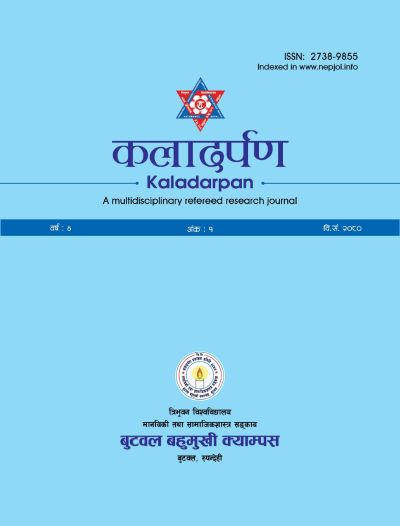बैरागी काइँलाका कवितामा आयामेली चिन्तन {Aayameli Perspective in Baragi Kaila's Poems}
DOI:
https://doi.org/10.3126/kaladarpan.v4i1.62824Keywords:
मातेको मान्छेको भाषण, तेस्रो आयाम, आयामेली, पर्वत, सपनाको लास, Third dimension, Aayemeli, Parvat, Manchheko Vashan, Madhyaratko SadaksitaAbstract
बैरागी काइँलाले आयामेली लेखनपूर्वका कवितामा परम्परित वर्णमात्रिक र मात्रिक छन्द तथा पछि आएर नवगद्य छन्दको प्रयोग गर्दै परम्परामुक्त कविता सिर्जना गरेका छन् । उनका कवितामा आयामेली चिन्तनलाई केकसरी प्रस्तुत गरिएको छ भन्ने मूल समस्यामा केन्द्रित रही यो लेख तयार गरिएको छ । प्रस्तुत लेखको मुख्य उद्देश्य बैरागी काइँलाका कवितात्मक प्रवृत्तिको चर्चा गर्दै उनका कवितामा व्यक्त आयामेली चिन्तनको निरूपण गर्नु रहेको छ । यस लेखमा पुस्तकालयीय कार्यमा आधारित रही आवश्यक सामग्री सङ्कलन गरी विश्लेषणात्मक विधि उपयोग गरिएको छ । यसमा निर्धारित कवितालाई प्राथमिक स्रोतका रूपमा लिइएको छ भने उक्त कविताहरूको विश्लेषणका लागि विभिन्न पत्रपत्रिका, अनुसन्धानात्मक लेख तथा पुस्तकलाई द्वितीय स्रोतका रूपमा लिइएको छ । कविता कृतिलाई साक्ष्यका रूपमा प्रस्तुत गरी विश्लेषण गरिएको छ । ‘पर्वत’ कवितामा मानिसले भोगेका पीडा, दर्द तथा उक्त पीडाको मुक्तिका निम्ति पर्वततर्फको यात्रा प्रारम्भ गर्नुपर्ने विषयवस्तु प्रस्तुत भएको छ । ‘मातेको मान्छेको भाषण ः मध्यरातपछिको सडकसित’ कवितामा क्रुर शासन व्यवस्थाका कारण कवि ‘म’ पात्रले सत्य कुरा बोल्नका निम्ति मातेको अभिनय गरेको छ । ‘सपनाको लास’ कवितामा मानिसले जीवनमा कहिल्यै पूर्णता प्राप्त गर्न नसक्ने, स्वतन्त्रता, इच्छा तथा आकाङ्क्षालाई तिलाञ्जली दिएर सामाजिक लोकाचार र बाध्यात्मकताका निम्ति भौँतारिएको अवस्थालाई प्रस्तुत गरिएको छ । यस लेखमा बैरागी काइँलाले आयामेली चिन्तनलाई केकसरी प्रस्तुत गर्दै लेखनकार्यमा सिद्धि प्राप्त गरेका छन् भन्ने विषयलाई तथ्यका आधारमा पुष्टि गर्दै बैरागी काइँलाले कवितामा आयामेली चिन्तनलाई पूर्णतः पालना गरेका छन् भन्ने निष्कर्ष निकालिएको छ ।
{Bairagi Kaila applied traditional Varnamatrik and Matrik Chhanda before the com[1]mencement of Aayameli movement in the Nepali literature. He began using Nawagdhya Chhanda to free the Nepali poetry from traditional way onwards this movement. This article presents the ways he used Aayameli perspective in composing the poetry. The main purpose of the study is to explore the poetic dimensions in Kaila's poems in terms of Aayameli movement. The data of sec[1]ondary source i.e. the materials available in the library has been. Inductive analysis is used to ex[1]cavate the insights of the study. The poems composed by Kaila are used as the primary source and the magazines, journals, research papers and newspapers are used as the secondary source. The poem, 'Parvat' depicts the difficulties and pains faced by the human beings and need of the jour[1]ney of the mountain for the emancipation of these sufferings. In the poem, 'Mateko Manchheko Vashan: Madhyaratko Sadaksita', the persona of the poem 'I' pretends to be hallucinated to ex- press the truth of the cruel ruling system of the contemporary time. In the poem, 'Sapanako Laas', reveals the situation how human beings become the victim of social responsibility and constraints to become perfect giving up their independence, desire and aspirations, and also presents the notion that human beings can never be perfect no matter what attempts they do for this. Over all, this study has attempted to show the ways Bairagi Kaila has adopted the dimensions of Aayameli Poetic Movement citing his above mentioned three poems and analyzing the themes of the poems.}




